January 12, 2024
Air Date: January 12, 2024
FULL SHOW
SEGMENTS
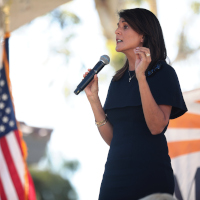
Nikki Haley on Climate
View the page for this story
Republican presidential candidate Nikki Haley sends mixed signals on climate change, acknowledging that it’s real and human-caused while also touting her role in pulling the U.S. out of the Paris Agreement. Inside Climate News reporter Phil McKenna caught up with the Haley campaign in New Hampshire and joins Hosts Paloma Beltran and Jenni Doering to examine Nikki Haley’s climate record and rhetoric as well as share feedback from voters. (06:29)

Beyond the Headlines
/ Peter DykstraView the page for this story
This week, Living on Earth Contributor Peter Dykstra joins Host Paloma Beltran with a couple of stories about thoughtful dwelling design. In sweltering Egypt, buildings that incorporate centuries-old techniques help naturally keep inhabitants cool. And in Florida, residents in a new development designed with plentiful rooftop solar and energy efficiency pay nothing for electricity. In history they look back to when the Nixon administration stepped in to block a massive jetport that could have impacted the delicate Everglades ecosystem. (04:14)
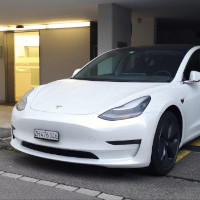
Electric Car Growing Pains
View the page for this story
The electric vehicle industry is undergoing a transformation as sales surge and automakers ramp up production in the U.S. Domestic manufacturing and sourcing requirements mean that only 19 models currently qualify for the $7500 federal EV tax credit, down from 43 in 2023. Dan Gearino of Inside Climate News joins Host Jenni Doering to explain the EV industry’s growing pains and why its future looks bright. (08:21)
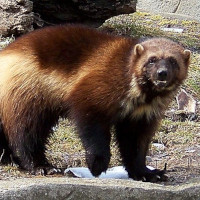
Wolverines at Risk
View the page for this story
Fierce and fuzzy wolverines are in decline, especially in the Lower 48 states where the U.S. Fish and Wildlife Service recently designated them as a Threatened species. Wildlife biologist Doris Hausleitner joins Host Jenni Doering to discuss how disappearing snow and habitat is affecting wolverines and share the creative techniques needed to study these elusive creatures. (10:52)

Fossil Fuel Deception
View the page for this story
The fossil fuel industry has known its products would cause dangerous warming for decades but chose to deceive the public to stall climate progress around the globe, says Naomi Oreskes, Professor of the History of Science at Harvard. She joined Host Steve Curwood to describe the fossil fuel industry’s decades-long disinformation campaign and what can be done to turn the climate conversation back towards the truth. (15:10)
Show Credits and Funders
Show Transcript
240112 Transcript
HOSTS: Paloma Beltran, Jenni Doering
GUESTS: Dan Gearino, Doris Hausleitner, Naomi Oreskes
REPORTERS: Peter Dykstra, Phil McKenna
[THEME]
DOERING: From PRX – this is Living On Earth.
[THEME]
DOERING: I’m Jenni Doering
BELTRAN: And I’m Paloma Beltran.
New Hampshire voters express concern about the climate crisis.
REED: I remember back in my day, this time of year, we had two, three feet of snow. You see any snow around here? There's something wrong. Way wrong.
DOERING: Also, federal protection for threatened wolverines.
HAUSLEITNER: They have a bear like face, and really long fur, and a really bushy tail. And they run in a funny, kind of loping weasel fashion. And they have exceptionally big feet, which they use to stay on top of snow.
DOERING: But that snow wolverines depend on is disappearing as the planet warms.
That and more, this week on Living on Earth. Stick Around!
[NEWSBREAK MUSIC: Boards Of Canada “Zoetrope” from “In A Beautiful Place Out In The Country” (Warp Records 2000)]
[THEME]
Nikki Haley on Climate
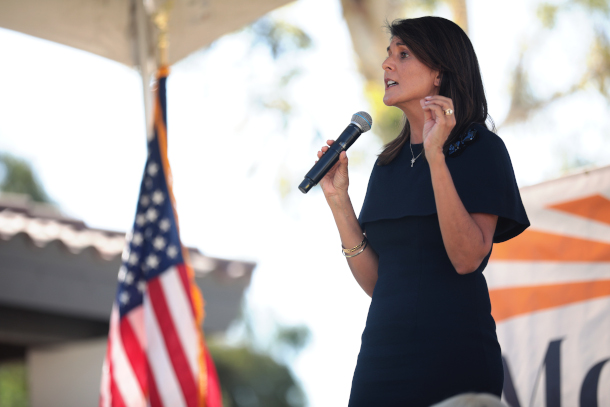
Nikki Haley announced her campaign for president in February 2023. (Photo: Gage Skidmore, Flickr, CC BY-SA 2.0)
DOERING: From PRX and the Jennifer and Ted Stanley Studios at the University of Massachusetts, Boston this is Living on Earth. I’m Jenni Doering.
BELTRAN: And I’m Paloma Beltran.
With the Iowa caucuses on January 15th and New Hampshire presidential primary on the 23rd, we’re kicking off our 2024 political coverage and we’re starting with Nikki Haley. You hear her name a lot, Jenni. She’s a former South Carolina Governor and Ambassador to the UN and she’s pushing hard for the Republican nomination.
DOERING: So let’s bring in Phil McKenna, he’s a journalist with our media partner, Inside Climate News who went to New Hampshire to get a closer look. So Phil, what did you see?
MCKENNA: So, Nikki Haley is set apart from many of her fellow Republicans by simply acknowledging that climate change is real & caused by human activity. But her proposals to reduce emissions would actually do little to address the climate crisis.
DOERING: Oh? In what ways?
MCKENNA: Well, she supports carbon capture & sequestration and planting trees, but she doesn't want the U.S. to curb the use of fossil fuels. And climate experts say that’s really key if we’re going to cut greenhouse gas emissions in line with the Paris Climate Agreement.
BELTRAN: So Phil, you attended one of Nikki Haley’s recent town halls. What happened there?
MCKENNA: Yeah, so this was at the Saddle Up Saloon in Kingston, New Hampshire, and it was packed, standing room only. When she spoke to the crowd, she focused on her tenure as U.S. Ambassador to the United Nations during the Trump administration. At one point, when listing her accomplishments in that role, she boasted about pulling the U.S. out of the Paris Climate Agreement.
HALEY: But when I got to the UN, I wanted countries to know what America was for and what America was against. I didn't care if they didn't like me, but I wanted them to respect America. And we got to work. We pulled ourselves out of the Paris Climate Agreement.
MCKENNA: In fact, many of her remarks on climate and energy revolved around foreign policy.
HALEY: And there were two things, when I was at the United Nations, that Russia, China, and Iran never wanted us to have. They never wanted us to have a strong military, and they never wanted us to be energy independent. We won't be energy independent, we will be energy dominant. *APPLAUSE* We will get the EPA out of the way. Right now they care more about sagebrush lizards than they do whether we can afford our utility bill. We will speed up the permitting process, we'll get our pipelines going, we'll do the Keystone pipeline, we'll export as much liquefied natural gas as we can. And we will make sure that we don't just have enough energy to survive. We'll make sure we turn our energy sector into an economic powerhouse. Let's export it out!
BELTRAN: Sounds a lot like a “drill, baby drill!” kind of message.
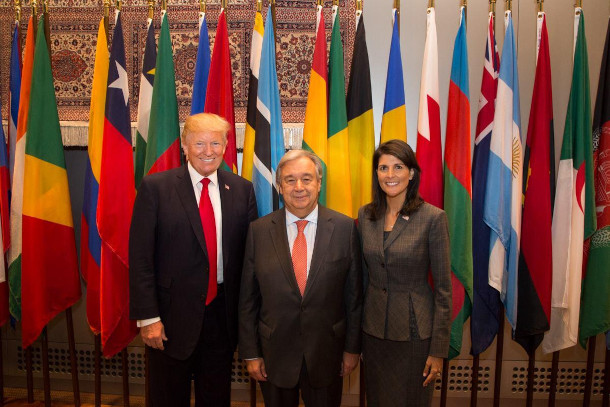
Many of Nikki Haley’s climate policies harken back to her tenure as U.S. Ambassador to the United Nations. Here she stands (right) with President Donald Trump (left) and United Nations secretary general António Guterres. (Photo: Shealah Craighead, White House Official Photographer, Flickr, Public Domain)
MCKENNA: Exactly. And overall, Republican voters in attendance seemed pretty enthusiastic about what Haley had to say. But I wanted to hear directly from them.
DOERING: Yeah, what was their reaction?
MCKENNA: Well, in contrast with Haley’s speech lots of folks I spoke to expressed concern about climate and the environment. Here's Lester Reed, a 77-year-old independent voter from nearby Plaistow after the event:
REED: Climate? They got to do something about that, and they got to do it now instead of pushing it off for tomorrow. I remember back in my day, this time of year, we had two, three feet of snow. You see any snow around here? There's something wrong. Way wrong.
BELTRAN: And what were people saying regarding Haley's stance on the environment?
MCKENNA: Many of those I spoke with said that they believed Haley would be a more environmentally friendly candidate than the other Republican candidates. But registered Republican Michael Bailey from nearby Derry said that despite his belief in climate change, he feels it's too late to move forward on any sort of climate action.
BAILEY: I think she probably is a very conscious climate person. Which is fine, and I admire that too. I think though that the climate change is too big to tame at this time. Any bit helps, sure, but it's just way too late.
MCKENNA: Michael Bailey then explained that he intends to cast his vote for Donald Trump.
DOERING: So, it sounds like some climate “doomers”, as they’re sometimes called, aren’t swayed by Haley’s stance on climate change.
MCKENNA: Yeah and that’s the case even though Nikki Haley’s climate platform rejects many of the Democratic party’s environmental moves. In a speech on “economic freedom” that she gave in September, she called for rolling back President Biden’s clean energy incentives, which she claimed would subsidize battery manufacturing abroad.
HALEY: We should also eliminate Joe Biden’s $500 billion in green energy subsidies. No more cash windfalls for China.
MCKENNA: But, although Haley is correct about the scale of the investment in green energy, most of the funding and tax credits in the Inflation Reduction Act is targeted toward domestic manufacturing and research and development.
BELTRAN: What about Nikki Haley’s record on climate as governor of South Carolina?

Inside Climate News writer Phil McKenna (Photo: Courtesy of Phil McKenna)
MCKENNA: She blasted the federal Clean Power Plan, which would have curbed greenhouse gas emissions from coal fired power plants. She also voiced her support for drilling for oil and gas off the coast of South Carolina.
BELTRAN: What did that look like?
MCKENNA: Well, for example, in 2013 Haley and her fellow Republican Governors from Virginia and North Carolina wrote a letter to Sally Jewell, who had just been nominated as Obama’s Interior Secretary. The letter asked Jewell to open up the waters off their states to offshore drilling, though that never happened.
DOERING: And what about developing renewable energy resources like solar and wind in her state?
MCKENNA: As Governor, Nikki Haley signed legislation that paved the way for the ongoing build out of solar power in South Carolina. However, she put little of her own political capital behind the bill, a compromise hashed out between electric utilities and solar power advocates.
BELTRAN: Overall, Phil, how prominent do you think the climate emergency is in this Republican primary season?
MCKENNA: Well, climate change is definitely not the main issue in the Republican primary this year. But it’s being discussed more than in the past. And as you heard, it’s certainly getting harder and harder to ignore.
DOERING: Thanks, Phil! Phil McKenna is a reporter with Inside Climate News.
We’ll catch up with you soon later down the campaign trail.
MCKENNA: Sure thing. Thanks Jenni, thanks Paloma.
Related links:
- Nikki Haley’s Energy Plan
- Nikki Haley’s Speech on Economic Freedom
- Nikki Haley on the Inflation Reduction Act
- Read more of Phil McKenna’s articles for Inside Climate News
[MUSIC: Percy Graingerm Dallas Wind Symphony, Jerry Junkin “Shepherds Hey” on Lincolnshire Posy, Reference Recordings]
Beyond the Headlines

Hassan Fathy’s work uses ancient architectural principles to help buildings in hot climates stay cool in sustainable ways. (Photo: Viktor Lazić, Wikimedia Commons, CC BY-SA 4.0)
BELTRAN: It’s time now for a look beyond the headlines, and on the line from Atlanta, Georgia is Living on Earth Contributor Peter Dykstra. Hey, Peter, what do you have for us today?
DYKSTRA: Hi Paloma. We're going to start with a situation where innovation is based on centuries and centuries of knowledge. This really, really interesting story out of the Washington Post, about an architect named Hassan Fathy. This is right after World War Two. Fathy in his native Egypt, started designing homes and communities, mostly for poor people. And those walls and designs and courtyards, in traditional Middle Eastern architecture, helped cool buildings in very, very typically hot climate, talking about over 100 degrees Fahrenheit during the day, thick earthen walls, courtyards that help channel winds to cool things off. And some really forward thinking ideas that are based on ancient ideas, not only in Egypt, but in Turkey as well.
BELTRAN: It sounds like we can learn a thing or two from Hassan Fathy about building for community while dealing with rising temperatures.
DYKSTRA: That's right.
BELTRAN: Well, what else do you have for us, Peter?
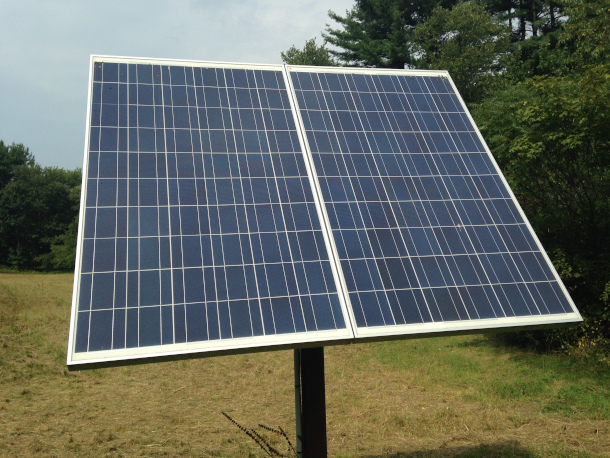
The residents of Hunters Point, Florida use solar energy primarily to power their homes and produce enough to sell back to the electrical company. (Photo: MarkBuckawicki, Wikimedia Commons, Public Domain)
DYKSTRA: We'll go to Hunters Point, Florida. It's a new community part of Sarasota on the Gulf Coast. It's the world's first LEED certified zero energy, residential development, 86 homes that produce their own electricity. And not only that, but they're able to sell some of it back to the utility. Not only is there no electric bill for much of the time at Hunters Point, but you actually can make money back. The community is dealing with solar and other means of energy conservation in a way that should be a model everywhere.
BELTRAN: And of course, Florida is prone to hurricanes, which come with a lot of blackouts.
DYKSTRA: A lot of blackouts, that's something else that Hunters Point, is able to overcome because in generating their own electricity, and being capable of being off the grid, they don't have to worry about those huge blackouts that come after huge hurricanes. And not only that, wait, there's more like they say on the TV commercials. It's in a very vulnerable spot in Florida on the Gulf Coast for hurricanes. But the community has built its roads raised up by several feet to help deal with storm surge, or sea level rise. They also have their own barrier islands, so Hunters Point will have much less damage in a hurricane than neighboring communities.
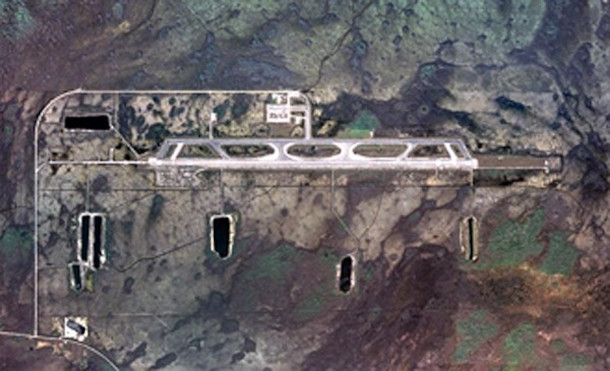
Although Nixon blocked the full construction of the Everglades Jetport, its remains can still be seen. (Photo: National Park Service, NPS.gov)
BELTRAN: Wow, energy efficient and storm proof. You gotta wonder, are they living in the future? Now I hear you have another story from Florida for the history books.
DYKSTRA: What appears to be a good idea from 1970, specifically January 14th, 1970, when several Florida State agencies came together with the White House and President Nixon to block completion of the partially built, Big Cypress Jetport was going to be a Mega Jet poured in the middle of the Everglades to serve both Florida's East Coast and the rapidly growing West Coast cities like Fort Myers. But there was worry that the building of the sprawling airport would do irreparable harm to Florida's Everglades. What's left of the Big Cypress Jetport can still be seen on Google Earth, some overrun runways and other vestiges of a project that was a really bad environmental idea.
BELTRAN: Well, thanks, Peter. Peter Dykstra is a contributor for Living on Earth. We'll talk to you again real soon.
DYKSTRA: All right, Paloma, thanks a lot, talk to you soon.
BELTRAN: And there's more on the stories on the Living on Earth website. That's loe.org.
Related links:
- Read the original Washington Post story about Fathy’s work.
- Learn more about Hunters Point.
- Visit the Big Cypress Jetport.
[MUSIC: JJ Grey & Mofro, “Orange Blossoms”, on Orange Blossoms, Alligator Records & Artist Mgmt., Inc.]
DOERING: If you enjoy the stories you hear on Living on Earth, please consider signing up for our newsletter. You’ll never miss a show, and you’ll have special access to show highlights, notes from our staff, and advance information about upcoming live virtual events. The Living on Earth newsletter is sent to your inbox weekly. Don’t miss out! Subscribe at the Living on Earth website, loe.org That's loe.org.
Coming up, EVs are in the fast lane but it’s a bit of a bumpy road. That’s just ahead. Stay tuned to Living on Earth.
ANNOUNCER: Support for Living on Earth comes from Sailors for the Sea and Oceana. Helping boaters race clean, sail green and protect the seas they love. More information @sailorsforthesea.org.
[CUTAWAY MUSIC: Miles Davis, “Freddie Freeloader” on Kind of Blue, Sony Music Entertainment]
Electric Car Growing Pains
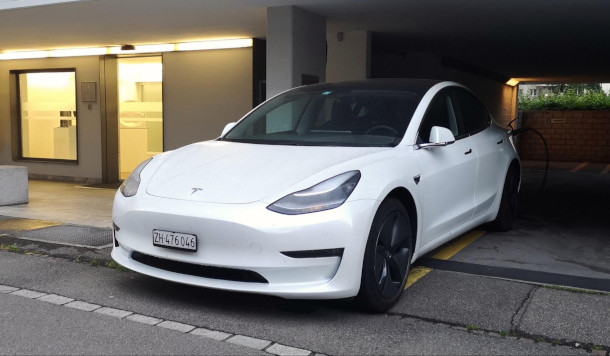
The Tesla Model 3 is among the 19 models that qualify for the full $7500 tax credit in 2024. (Photo: crash71100, Flickr, public domain)
BELTRAN: It’s Living on Earth, I’m Paloma Beltran
DOERING: And I’m Jenni Doering.
Electric vehicles are usually more expensive than gas-powered ones, but a federal tax credit of $7500 renewed by the Inflation Reduction Act offers a high-octane incentive for Americans to go electric. For consumers to qualify for the credit, automakers must have met certain standards, like sourcing battery materials primarily from the US or trade partners and doing final assembly here in the U.S. The tax credit is designed to entice automakers back from China and its lower labor costs, especially in the wake of the “Big Three” U.S. autoworkers strike last year that won historic contracts with big pay raises. The rules linked to the tax credits had a gradual phase in to give automakers a little more time to build up domestic supply chains. But they’re not quite there yet, so as we enter 2024, only 19 models are now eligible for the full $7500 taxpayer credit when purchased new, down from 43 models last year. Dan Gearino reports for our partner Inside Climate News. Dan, how’s this transformation going?

Dan Gearino is a reporter for our partner Inside Climate News. (Photo: Brooke LaValley)
GEARINO: So this is one of those classic kind of questions where the answer is, it depends on who you ask. And it depends on from whose perspective. So how is it going in terms of encouraging US manufacturing? From that frame, it's going great. It is just this wild success. We're talking 10s and 10s, and 10s of billions of dollars of investment. Almost every major automaker is putting a ton of money into building batteries and the battery components and to sourcing their stuff from the US or from US allies. So from that perspective, this is a great success. For a consumer, or for a car dealer who wants a really simple tax credit, who wants a tax credit that's available on a whole bunch of vehicles, it's not as great because it's more difficult for these vehicles to qualify. So if I want to go shop for say, a Hyundai or a Kia vehicle, none of them qualify if I'm buying a new vehicle. If I want, you know, Volkswagen, BMW or some of, you know, some of the German brands, you don't see many of them qualifying. A lot of the Tesla vehicles do qualify, but certainly not all of them. Hyundai and Kia though are also adjusting the way that they produce vehicles and where they produce vehicles so that one day they'll be able to get this same credit. So it's tougher for consumers. But the idea is that this will become simpler for consumers a couple years from now, when companies have adjusted the way that they source this stuff.
DOERING: Well, if somebody does need a new car right now, maybe listeners are thinking about purchasing an EV, with these fewer models qualifying for the tax credit in the meantime, that doesn't exactly sound like good news. But to what extent is there any kind of silver lining for those listeners?

While new Hyundai EVs do not qualify for the tax credit in 2024, reporter Dan Gearino says their current EV lineup is still relatively affordable. ((Photo: Automotive Rhythms, Flickr, CC BY-NC-ND 2.0)
GEARINO: A typical electric vehicle is more expensive than a typical gasoline vehicle. But there's a really wide spectrum in terms of how inexpensive some of these vehicles are. Kia and Hyundai have done a great job with their EV lines. They have models that get great reviews, they have models that are also pretty affordable, even without tax credits. But if you're looking at tax credits, just for new vehicles, there is a relatively small selection. But there's also a $4,000 credit for used plug in vehicles. And just looking at some of the vehicles available in my market, in Columbus, Ohio, there is a more robust used EV market now with lots of options available, than there was a year ago. Also for leased vehicles, the manner in which leasing companies will acquire these vehicles allows them to get a tax credit. And that tax credit doesn't have as many restrictions as the credit for consumers buying new vehicles. The upshot is that some of those brands that don't qualify for the tax credit, can get a tax credit if you're leasing. The specific details of that you need to figure out with a dealer, but whether it's leasing or buying a used car, and then these options for buying new cars. I should also say that some manufacturers are doing their own tax credit. They didn't qualify for the US government tax credit, but they'll just do an equivalent discount on the vehicle of the same amount. You just need to kind of just shop around and see what the options are out there.
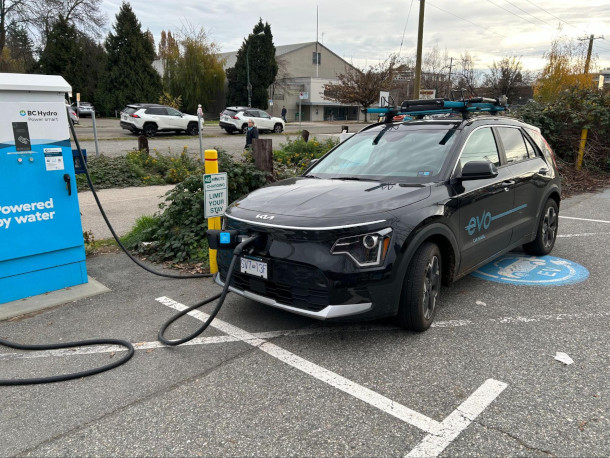
The number of new vehicles that qualify for the full $7500 credit has dwindled, but there is a $4,000 tax credit for used plug-in vehicles. Leasing an EV can also provide options for tax credits. (Photo: Stephen Rees, Flickr, CC BY-NC-ND 2.0)
DOERING: So how are American consumers responding to these EV tax credits in terms of which cars they're choosing to buy?
GEARINO: There has been this fascinating dynamic this last year where sales of EVs have absolutely skyrocketed. But at the same time, production of EVs have also skyrocketed. And there are concerns from some automakers that the increase in demand has not quite kept pace with the increase in supply. And that is a dynamic that is difficult to kind of get your arms around because you could simultaneously say 2023 was the greatest year ever for the US EV market. And you could also say that 2023 was a year when the EV market went through some growing pains that were at times really difficult. And you wouldn't be wrong. You could assemble a really, you know, compelling batch of evidence to make both of those cases. You know, the truth, of course, is that they're both true. And from the consumer's perspective, what I tell people when they ask me, you know, should I buy an EV now, the number of vehicles that are going to be available, and the price competition that will drive prices down. It's like, every six months or so you're in a bigger market with more options and more vehicles you can go and get a test drive on. Now at the same time, though, this idea of if you want to get your first EV maybe wait six months, on a macro level, that's disastrous, you know. So if I'm talking to a friend, I'll say, you know, you're gonna have a couple of these options in six months that aren't here now. But right now you have a lot more options than you did a year ago. Also, companies are gonna get better at making batteries. They're gonna just get better at this, the more that they do it. So yeah, I would say it's a very good time to buy an EV, but it'll be better in six months. It'll be even better in a year. It'll be even better than you know, going out into the future.
DOERING: What do you think we should be expecting from the EV market in 2024?
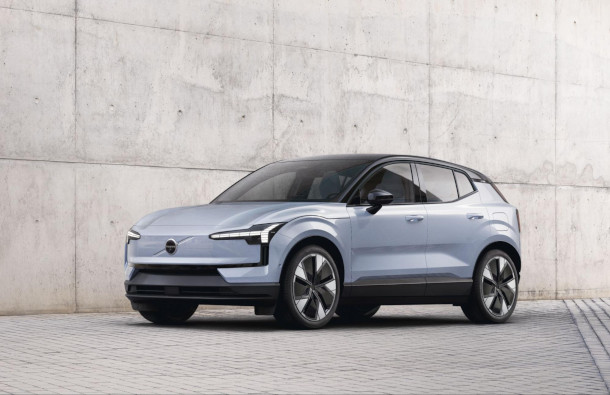
The 2025 Volvo EX30. (Photo: Automotive Rhythms, Flickr, CC BY-NC-ND 2.0)
GEARINO: The EV market in 2024 is going to continue to grow by a lot. The question is how will the growth rate compare to 2023, which was substantial growth. Just seeing record growth all the time isn't enough. You need record growth by a lot. And you also are seeing a maturing market where maintaining growth levels gets increasingly difficult. So I think that one of the key variables is how well for example, General Motors does in its EV rollout. Do they have some successful models? Can they produce enough vehicles? Just some of the challenges that they faced, are they able to overcome them? You look at like the Ford F-150 Lightning truck. And that's one that's done healthy sales. How much is that going to grow? I mean, that could grow a lot in 2024. You also look at Tesla, a company that's had, again, had some issues. I certainly don't expect the Cybertruck to be a super big sales success. But some of their other models, there's room for growth. But they don't have like a big debut coming up. And it's, there's a real question as to whether they can sustain some of their sales growth without that. Two vehicles that I want to test drive because I'm considering buying them are the Chevy Equinox, and then also the Volvo EX30. I think the Equinox is a real opportunity for GM, if they don't screw it up. The Volvo EX30, its price point is really good. It looks like it's a really attractive vehicle. I think the brand equity for Volvo was really exceptional. Also, Hyundai and Kia have a bunch of options that are really good. And it wouldn't be that surprising if you saw in particular, Kia just kind of build momentum as this leading EV producer. I mean, they already kind of are. But this could be a year where they really solidify that status. But all in all, it's going to be a big year. It's just a question of how big and in order to make the transition away from fossil fuel vehicles, you need a lot of growth. And whether or not it's enough is an interesting question.
DOERING: Dan Gearino is a reporter for our partner, Inside Climate News. Thank you so much, Dan.
GEARINO: Thank you.
Related links:
- Inside Climate News | “The (Pretty Short) List of EVs That Qualify for a $7,500 Tax Credit in 2024.”
- Credit Requirement Guidelines from the Treasury Department
- Full List of Qualifying EVs in 2024
[MUSIC: The Backing Tracks, “Drive My Car – Full Instrumental Performance with Guitar” on Play Guitar With The Beatles 1962-1966, Wise Publications]
Wolverines at Risk
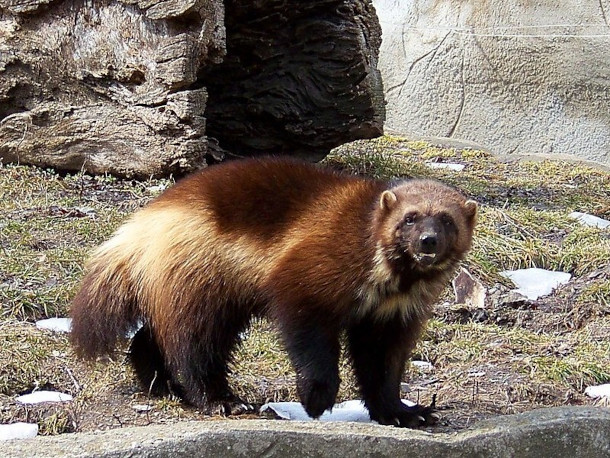
Wolverines have big bushy tails and tiny ears. (Photo: Maia C, Flickr, CC BY-NC-ND 2.0)
DOERING: The U.S. Fish and Wildlife Service recently listed wolverines in the Lower 48 as threatened under the Endangered Species Act. Despite being fierce scavengers and predators who have been known to take down moose and deer more than twice their size, wolverines are declining across both the U.S. and Canada. And the 300 or so wolverines south of that border are becoming increasingly isolated from each other and from larger populations further north. That’s bad news for genetic flow to connect various populations and improve resilience to things like environmental change, disease, and habitat fragmentation. Here to speak with us is wildlife biologist Doris Hausleitner. Hi there, welcome to Living on Earth!
HAUSLEITNER: Thank you for having me.
DOERING: So I think most of us have heard of Wolverines. But a lot of people just can't picture one. What is a Wolverine exactly?
HAUSLEITNER: Well, that's a great question. Wolverines are more often heard of than seen. And so that's not surprising. I like to think that a wolverine is like a medium sized dog, like an Ozzy Shepherd size. And they have a bear-like face and really long fur, and a really bushy tail. And they run in a funny kind of loping weasel fashion because they are the largest member of the weasel family. And they have exceptionally big feet, which they use to stay on top of snow. They naturally occur at low densities. And they're also quite elusive and don't love to be around humans. And so we don't often see them we often see their tracks.
DOERING: How do you study them if they're so good at avoiding humans?
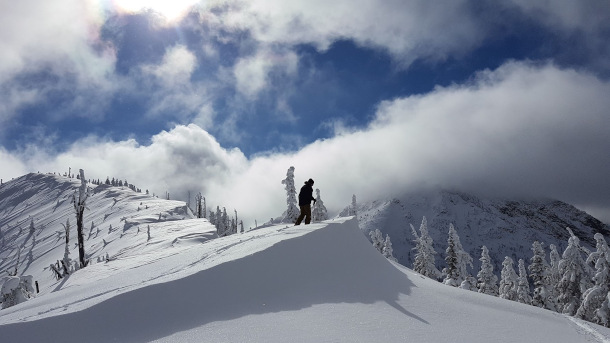
Wolverines live in extremely remote areas, forcing researchers to travel through the wilderness to study them. Here, Andrea Kortello tracks a wolverine. (Photo: Doris Hausleitner)
HAUSLEITNER: That's a great question. Yeah, we have decided for our project that we want to study them using non invasive means. And so that has been challenging. We do several things. One, we have used non invasive genetic techniques. So we set up a bait station with a lure, and we often set that up in a tree, and we're trying to entice the wolverine to climb the tree to reach for the lure. And while they're doing that, they have to go through these snarls of barbed wire. They have really thick skin. But in the meantime, what they do is they just leave a little bit of hair behind. And the hair is so useful because we can tell first what species it is. And then we can tell what gender it is. And we can tell who it is, so all the way down to an individual. And at the same time as they're going through the barbed wire, we have the bait set up in a way that the wolverine has to stem out with all four legs, and a camera set up across from the bait, taking photos. And each wolverine has a unique chest blaze. And so we can also confirm individual using that chest blaze. And we can tell whether it's a male or female from the genitalia. And if it's a female, we look for signs of lactation. And if they're lactating, we get a little bit more information on reproductive output all in the same time.
DOERING: Wow, that's amazing. So this is like getting pretty up close and personal with the wolverine, but with the help of a camera.
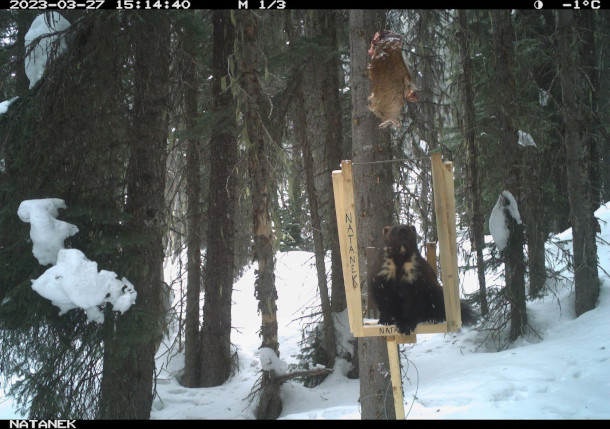
Wolverines are quite good climbers. Researchers take advantage of this by putting bait in trees that puts wolverines in front of a camera, allowing them to get a close-up shot. They also position the bait so that the wolverines must stand on the hindlegs to reach it, allowing the researchers to see their individual chest blaze. (Photo: Andrea Kortello, courtesy of Doris Hausleitner)
HAUSLEITNER: It's a bit intimate. Yes.
DOERING: So I understand that wolverine populations have been decreasing over the past decade or so. Why is this and what threats do wolverines face?
HAUSLEITNER: Yeah, so wolverine have been decreasing over the last decade. And scientists have seen these decreases in population numbers. And in Canada, we've seen this even in areas that are not harvested. So in Canada, we still do have a harvest for wolverine for pelts. But even in parks where there is no harvest allowed, we're seeing a decline. And so we anticipate that the decline is because of an increased amount of recreational users, particularly since COVID. We also have the worry of climate change to add to the decrease in wolverine populations, partly because climate change means less available snow in the mountains, and having less available snow also concentrates recreational users. And so it's sort of a two pronged sword. Snow is needed for denning and for caching food and for moving for wolverines. And we love snow to ride and slide on.
DOERING: Now, the Biden administration here in the US recently listed wolverines as a threatened species. What finally pushed them to do this?
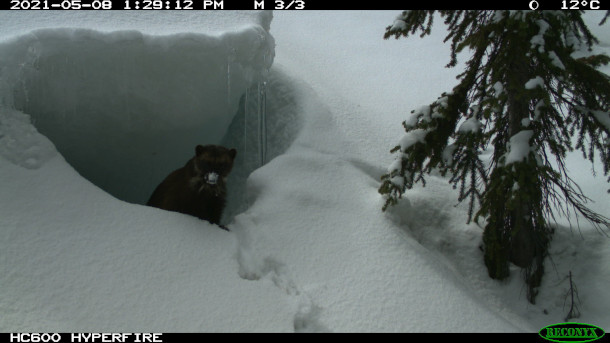
The climate crisis poses a challenge to wolverines who den in snow from February through May to raise their kits. With the snow melting earlier and earlier, denning becomes more difficult. (Photo: Andrea Kortello, courtesy of Doris Hausleitner)
HAUSLEITNER: Yeah, there are a number of reasons they were listed, but the genetic studies that we're doing are showing that there's a bit of a disconnect with genetic flow. And wolverines in the US are really, the populations are really contingent on keeping that genetic flow. Also, there's just more research and more information available on the actual numbers of wolverine. And they're not as good as we had hoped.
DOERING: And here in the lower 48 of the United States, what are some of those numbers currently for wolverine populations?
HAUSLEITNER: Yeah, the estimate is in the hundreds, not the 1000s and more like 300 is estimated. And those numbers are not high.
DOERING: Especially if they're so spread out, right?
HAUSLEITNER: Yeah, exactly. Just having such low densities. You can imagine the impact of even one or two individuals are lost from the population.
DOERING: Yeah, so what can people do to reduce their impacts on wolverines as they enjoy winter sports like skiing?
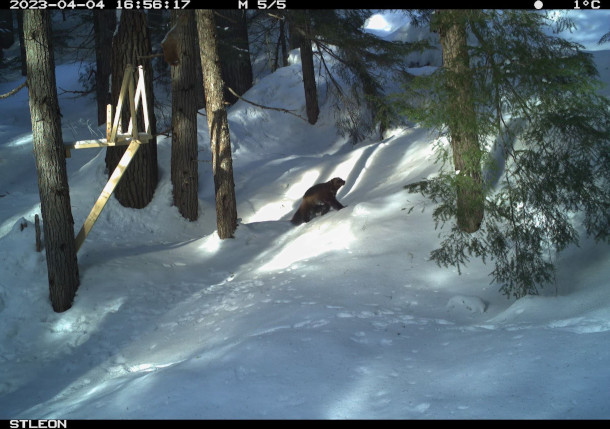
While the wire on the traps set by researchers may seem harsh, wolverine skin is so thick that it doesn’t cause them any pain. Rather, it snags their fur, allowing researchers to gather a DNA sample. (Photo: Andrea Kortello, courtesy of Doris Hausleitner)
HAUSLEITNER: That's a great question. So people can get familiar with what a wolverine track looks like. And once they get to know a wolverine track, if they cross track, when they're recreating no big deal. Wolverines move all over the landscape. And so if they see sort of a singular track, kind of moving on into the horizon, they should just be thrilled that they saw it, take a photo and enjoy their day. But if they're snowmobiling or skiing, and they come across a concentration of tracks, like tracks that are meandering, moving in and out of rocks, and maybe even tracks of multiple ages, where you can kind of see that the snow has covered some tracks and there's some new tracks, then, that is a good indication that you're in a dining area, because wolverine don't hang around one place for very long unless they're denning. And if you run into that, then the suggestion is to leave that area as soon as possible and stay out of it during the denning period, which is mid February to mid May.
DOERING: And I imagine you know, at a ski resort where there's always a lot of people around this is probably less of an issue, but are we talking about like backcountry skiing, things like that?
HAUSLEITNER: Yeah, correct. Mostly, if you're at a resort, you're the wolverines have probably already moved out of that area. But this is typically for people that are backcountry recreating either mechanized users so that could be cat skiing, or heli skiing or snowmobiling, or non mechanized users which is like snowshoeing or skiing, backcountry skiing, or even cross country skiing.
DOERING: Mm hmm. And what happens when humans move into their territory on skis or on a snowmobile or on snowboards, for that matter?
HAUSLEITNER: You know, wolverines are sort of known for their feisty nature, but they are really, really sensitive at denning areas. And so if wolverine feels threatened at her den, the wolverine mama, she will move her kits. And so that movement is detrimental for two reasons. One, she could be vulnerable to predators while she's moving her kits, she can only move one at a time, so she's to leave one alone. And two wolverine females will provision their den sites prior to denning. And so they will cache all sorts of food items in snow, they use it like a refrigerator. And if they're forced to move, then they don't have access to the parlor anymore. And those food items are harder to come by.
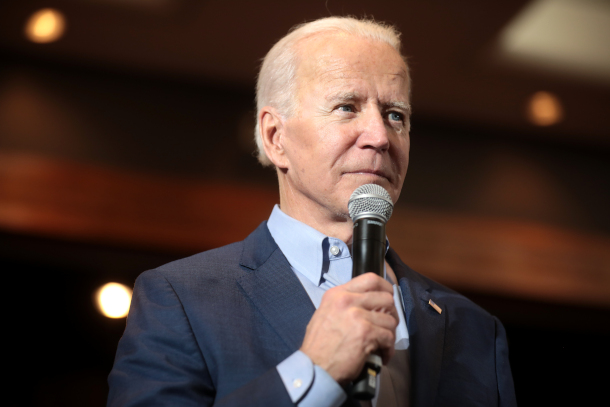
Due to increasing research indicating that the population of wolverines in the U.S. is decreasing, the Biden administration has listed them as “threatened” under the Endangered Species Act. (Photo: Gage Skidmore, Wikimedia Commons, CC BY-SA 2.0)
DOERING: And Doris, what got you interested in studying wolverines?
HAUSLEITNER: Oh, you know, I always saw wolverine tracks when I was recreating backcountry skiing. And you know, I'd be doing like 10 switchbacks. Wolverine would just be going straight out this mountain and always are in the most wild, beautiful places. They just invoke this sense of awe and wonder that is just so special. That I was I've just been drawn to them. Yeah. Since I was a kid.
DOERING: And have you seen one in the wild?
HAUSLEITNER: I have been so lucky to see a few in the wild. But funny that since I've started this study, which has been over a decade, I have not seen one while I've been on the research project. I've done a lot of tracking, and I've seen a lot of photos and camera traps, but I have never seen one in-person. But I was lucky enough to see some in the wild when I was recreating. I was actually in the Yukon. And I was driving in the middle of the night and the midnight sun and I came over a rise and there were two juveniles wrestling on the middle of the road. And it was I was I was just in shock. It was an amazing encounter for sure.
DOERING: Wow, that's so cool. They were wrestling you said?
HAUSLEITNER: Yeah. And in my mind, I'm totally anthropomorphizing, but I in my mind, their mom had like stashed them away and told them to behave and they had gotten out and decided to wrestle on the road instead.
DOERING: Doris Hausleitner is a wildlife biologist with Seepanee Ecological Consulting. Thank you so much Doris.
HAUSLEITNER: Oh it's been a real pleasure. Thanks Jenni!
Related links:
- Read more about wolverines.
- Understand the difference between threatened and endangered species.
- Learn more about why gene flow is vital for adaptation.
[MUSIC: Armchair Boogie, “Wolverine” on What Does Time Care?, GlueBrass Records]
BELTRAN: Just ahead, the delayed climate response is no accident. It’s exactly what fossil fuel companies were gunning for when they locked in on a campaign to deny the science of climate change decades ago. Keep listening to Living on Earth.
ANNOUNCER: Support for Living on Earth comes from Friends of Smeagull the Seagull and Smeagull’s Guide to Wildlife. It’s all about the wildlife right next door to you! That’s Smeagull, S - M - E - A - G - U - L - L, SmeagullGuide.org.
[CUTAWAY MUSIC: The Arcadian Wild, “Finch In The Pantry” on Finch In The Pantry, The Arcadian Wild]
Fossil Fuel Deception
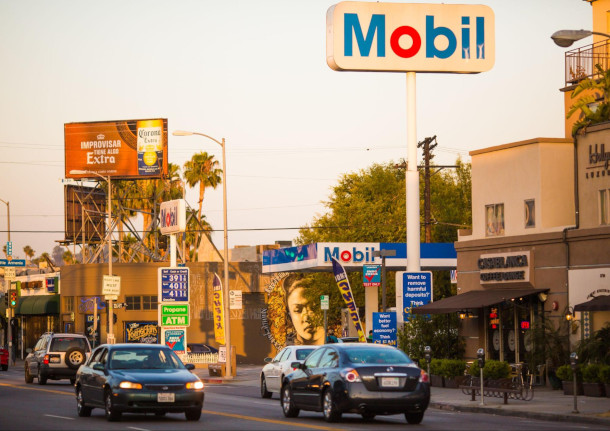
Starting in the 1980s, Exxon Mobil and other fossil fuel companies began an aggressive misinformation campaign designed to discredit climate science. (Photo: Thomas Hawk, Flickr, CC BY-NC 2.0)
DOERING: It’s Living on Earth, I’m Jenni Doering
BELTRAN: And I’m Paloma Beltran.
The burning of fossil fuels is the primary source of climate-warming greenhouse gases worldwide. And the science tells us that if we don't drastically reduce those emissions as soon as possible, we’re headed for even more catastrophic climate disruption. But by 2030 the UN reports that global fossil fuel production is set to be more than double the level consistent with meeting the goals of the Paris Climate Agreement. The dominance of the fossil fuel industry even as we face the climate emergency isn’t all that surprising, says Naomi Oreskes. She’s a professor of the history of science at Harvard and says the fossil fuel industry has stalled climate progress around the globe for decades. Professor Oreskes recently joined Living on Earth’s Steve Curwood to describe the industry’s campaign of disinformation.
CURWOOD: So how far back did big oil companies know about the potentially catastrophic effects their products could have on the climate and the planet?
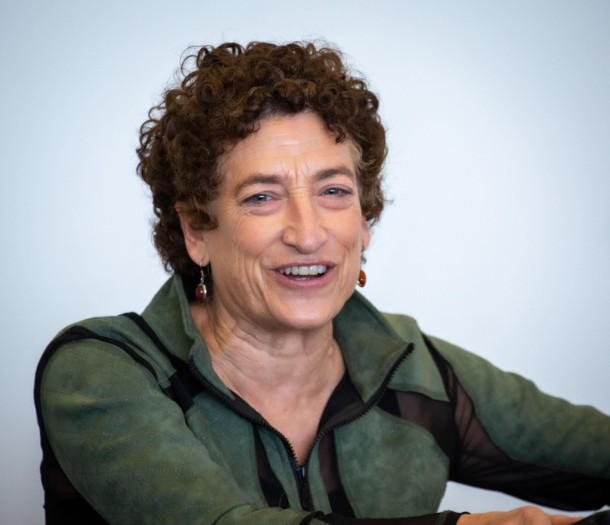
Naomi Oreskes is a Professor of the History of Science at Harvard University. (Photo: Jonathan Sachs)
ORESKES: We know from our research and the research of others that as early as the 1960s, the oil industry was quite well aware that burning fossil fuels put greenhouse gases into the atmosphere. And those gases were almost certain to warm the planet. And they also knew that the effects would likely be very serious. We begin to see really serious sustained work on the issue in the 1970s. And by the mid to late 70s, some companies like ExxonMobil actually had their own in-house scientists doing this research. And so we've shown, in our work, we've gone back and we've looked at those reports, we've looked at the scientific papers that were published, either by industry scientists or co-authored by them with academics. And they show very clearly that by the late 70s, early 80s, the oil industry had a very clear picture of what this problem was, understood that it was serious, that it would have large social, economic and political consequences, that it could include very substantive sea level rise, and that it might make their product unsellable.
CURWOOD: Go back to the very beginning. What was the first sort of shot across the bow, so to speak, inside industry? Who spoke up and said, whoa, whoa, whoa, whoa, we really could have a problem here.
ORESKES: Well, there's a few different shots across the bow. One of my favorite early examples is the physicist Gilbert Plass, who worked for Ford Motor Company. So we have reports from the 50s and 60s where the car industry is beginning to recognize that this could have significance for their long term business model. But also, Plass worked for Ford Aerospace. And they were interested in heat seeking missiles, and the impact of CO2 heat absorption on heat seeking missiles. So Plass did some of the most important early work that proved that climate change would result from increased CO2 in the atmosphere. So that was in the mid 1950s. We also know that in the early 60s, there were a number of studies and reports done, including one by Edward Teller, the famous physicist who spoke to the American Petroleum Institute about this issue. We have a number of reports that my students actually tracked down of air pollution conferences in the early to mid 1960s, where scientists were talking about CO2 as a form of air pollution. And we know that auto industry executives, oil industry executives, chemical industry executives, were present at these meetings and heard these conversations and in some cases participated in them.
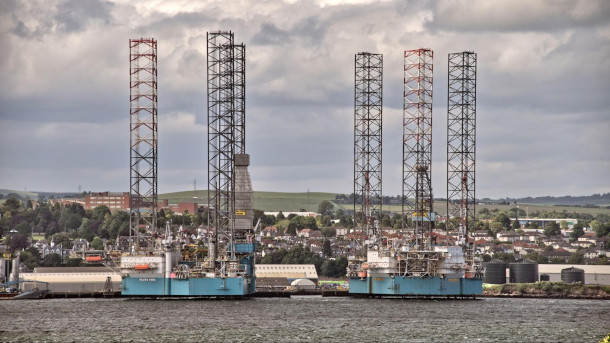
The fossil fuel industry was aware of the potential effects of their product as early as the 1960s, according to Harvard professor Naomi Oreskes. (Photo: Geoff Hansen, Flickr, CC BY-ND 2.0)
CURWOOD: So what did big oil companies do with that information?
ORESKES: Well, at first, they didn't actually do much of anything. And one of the things that's been interesting to us and the research we've done on the 1960s, is that in the 1960s, there's this conversation going on, that the oil industry doesn't seem to be particularly worried about. And my interpretation of that is that so long as climate change seemed far off in the future, they didn't really think it was something that they had to worry about terribly much. Now, a couple of companies did, and ExxonMobil is the most famous because they actually created a research group to better understand the problem. And they did that in the 1970s. So we know that they were taking it seriously. And we know that their own scientists wrote a number of reports that said, yes, this actually is significant. It is something that companies should be paying attention to. But even then, most scientists in the 1970s still thought that change was pretty far away. And a lot of the reports don't actually specify when they think discernable effects would occur. But when they do use a number, they sometimes use the year 2000. And sometimes when scientists talked about the issue, they talked to the year 2100. So you can imagine if you were a corporate executive in 1975, and someone comes along talking about climate change as something that would happen in the year 2100, you might reasonably think, hmm, that's not something I really need to worry about. But what we've seen in our work is that it begins to change very dramatically. And in a very specific year: 1989. 1989 is when we first begin to see climate change denial begin to be a thing. So we begin to see reports, advertisements, OpEds, to say, well, hold on, slow down, we don't really know, we're not really sure. And so one obvious question is why then? And I think we know the answer, because 1988 is the year that Jim Hansen testifies for the first time in the US Congress, that manmade climate change is underway. And he testifies to the effect that he and his team at NASA are 99% sure that this is the case. And you know, as well as I do, scientists hardly ever say they're 99% sure about anything. So it's this very strong, very clear, quite unequivocated statement. And 1988 is also the year that the IPCC, the Intergovernmental Panel on Climate Change, is created. So you have these two big things happening to say, okay, we've been talking about this as something that's far off in the future but actually, this is happening faster than we thought and if Hansen is right, it's actually already happening now. And I think that scares the pants off the oil industry. And I think that helps to explain why we then see this big pivot.
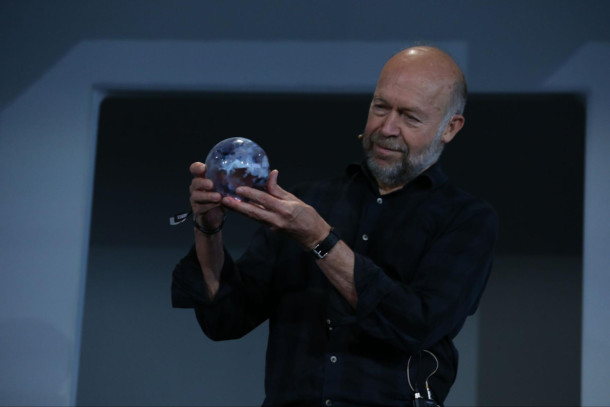
Scientist James Hansen testified in Congress in 1988, saying his NASA team was 99% certain manmade climate change was already underway. He’s pictured here in 2017. (Photo: MIT Media Lab, Flickr, CC BY-SA 2.0)
CURWOOD: Yeah, I mean, what did they do with that information, that climate change is here and now, as of 1988?
ORESKES: Well, a few things. One thing we know is that Exxon Mobil disbanded its climate research program. So they had a whole group that was doing CO2 climate modeling. And they also had a group that was actually measuring carbon dioxide at sea. And we know that that whole group was disbanded. So they stopped doing the research that would potentially contribute to a better understanding of what was really happening. And instead, they shifted away from science and towards an anti-scientific position, towards disinformation. And so they begin to fund a whole series of opinion pieces. They're really advertisements, but they're formatted to look like opinion pieces, which they publish in the New York Times. And they also begin to form groups, lobbying groups, to begin to work against climate action.
CURWOOD: Specifically, talk to me about the strategies that these companies used to mislead consumers and the public about the dangers of fossil fuel. What was the message that was put out there about this, to support this approach?
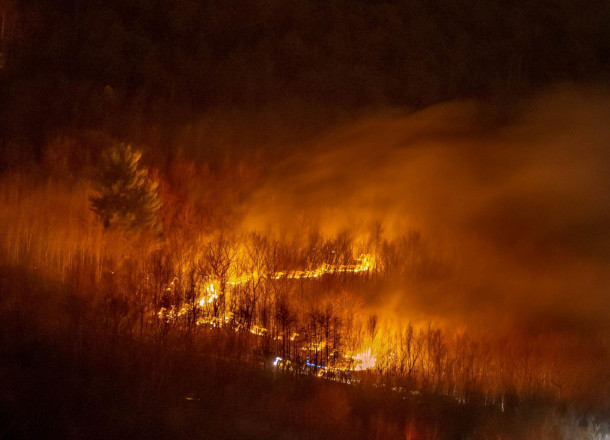
Many fossil fuel companies claimed that climate science was too uncertain to cause alarm and conclusively link to climate driven events such as wildfires. (Photo: Project LM, Flickr, CC BY-NC-ND 2.0)
ORESKES: There was a wide diversity of messaging that was used. But my Research Associate, Geoffrey Supran, and I have identified four big themes that we see repeated over and over again, and we summarize them as follows. It's not real, it's not us, it will wreck the economy, it's too expensive to fix. So the first one, it's not real, was a strategy to deny that climate change was even happening, to say the science was too unsettled, there were too many uncertainties, to blame it on natural variability, to say the climate has always changed, to blame it on volcanoes. So basically, to deny the scientific evidence. Second one, it's not us, which is a variation on the theme of the first. Well, maybe there is warming, but it's not caused by our activities. So it's actually just natural variability, it's actually caused by CO2 from volcanoes. Two B is, it's not us, it's China. So deflect attention from what we, here in the United States, or what we, ExxonMobil, have done to try to deflect the blame and put it on someone else. Then the second two, the third and fourth, were about the economy. So to claim that if we were to stop using fossil fuels, it would completely wreck the economy, the economy cannot survive without fossil fuels. This is an argument that we're seeing revived again, even as we speak today. And then the fourth is that it would be too expensive to fix. So yeah, we could do solar, we could do wind, but they're too expensive. And also, they're too intermittent, right? I call this the, "renewables are for sissies" argument, that renewables aren't tough enough, they're not reliable enough, that only oil, gas and coal are reliable. So there's this sort of gender laden element about, you know, real men drill for coal. And so we've seen all four of these arguments being used at different times in different ways. I always like to say, some people think that the industry doesn't believe in recycling, but they do, they recycle their refuted arguments.
CURWOOD: From your perspective, what were some of their most effective techniques of disinformation?
ORESKES: I think they were very smart about something that, you know, social media has exploited in recent years, but they already knew this 40 or 50 years ago, which was targeted messaging. And so in a place like Kentucky, they would push a message about losing jobs. If coal is wiped out, you'll lose your jobs. In a place like, I don't know, California, they would have a message about government overreach or increases to your taxes. They also had different arguments or different messages for male and female audiences. So the incredibly effective thing they did was to recognize that there wasn't one thing, and to do a whole lot of different things, also different media: radio, television, print media, and then now we're seeing tremendous amounts of growth of disinformation on social media.
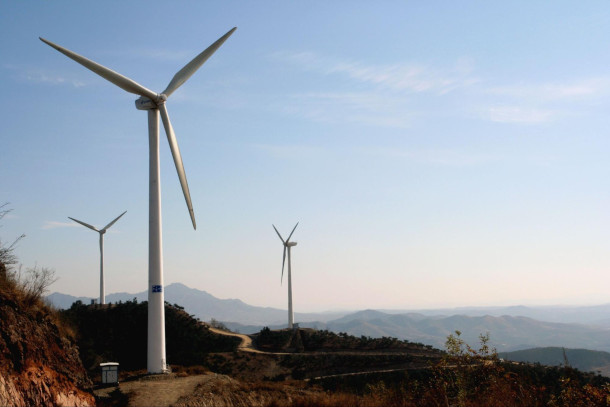
Fossil fuel companies have also argued that renewables are less reliable than fossil energy sources. (Photo: Land Rover Our Planet, Flickr, CC BY-ND 2.0)
CURWOOD: Naomi, I understand that there was some really ridiculous, maybe even outlandish advertisements back in the 1960s in magazines. Could you describe one of those spreads for me, please?
ORESKES: There's a very famous advertisement that was put out by Humble Oil, which was part of this Standard Oil, The John D. Rockefeller network, where they showed a giant glacier and they talked about how much energy it would take to melt the glaciers if that were a good thing. And I think that's a very nice telling example for us of how our mentalities have changed. Right around the time that scientists were starting to understand how climate change could melt glaciers, and that would be a bad thing, we have people advertising that being able to melt a glacier was a good thing. So part of this story is that it has required us to rethink how we think about nature, the environment, living on earth. And so the difficulty of this story is, it's not just about disinformation from the fossil fuel industry, but the way in which that disinformation has worked in conjunction with our own fears, anxieties, beliefs, attitudes, to get us to this place where we are today.
CURWOOD: So, this may seem obvious, but what convinces you that this whole process of misinformation was deliberate? That these weren't sort of people who mistakenly didn't quite get what was going on?
ORESKES: Well, that's an easy question to answer, because they said so. I mean, as a historian, I work with documentary evidence. We've spent a lot of time in the archives, we've visited archives in I don't know, at least 20 states, I think, as well as looked at lots of documentary material that is available online. And we see how this was planned. We see how it was organized, we see the documents that say, you know, we're going to say there's no consensus on climate change, we're going to design this advertising campaign, and we're going to run it in these places. And we came across documents that even had focus group studies. They did market research to try to figure out what kinds of messaging would be most effective in persuading the American people not to support meaningful climate action. So we don't have to interpret, we don't have to read between the lines. This is all things that they said, they wrote down. And of course, the other big piece of this puzzle, and this is the work that Eric Conway and I did in our book, "Merchants of Doubt," some of the key players in climate change disinformation came out of the tobacco story. So we showed in our book how two of the original four Merchants of Doubt had worked directly with the tobacco industry, had worked on these strategies for tobacco, and then carried those strategies and tactics into the climate space.
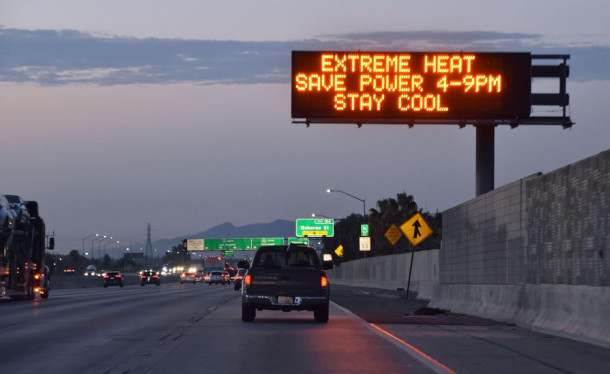
Other advertisements have claimed that global warming was due to natural variability, not human activity. (Photo: Chris Yarzab, Flickr, CC BY 2.0)
CURWOOD: So talk to me about how these disinformation strategies have changed over time. You mentioned that climate disinformation has moved to social media. So what does the fossil fuel climate denial marketing campaign look like today?
ORESKES: Well, it's a little hard to answer that question, because one of the things about social media is that it's so segmented, but one message we are definitely seeing today is a revival of the anti government message, to say that this is all a liberal conspiracy to take away your rights, to take away your hamburgers to take away your right to drive a big car. And this particularly came up in the recent debates about gas indoors. So in New York State, when the state proposed a regulation that would not allow gas in new homes, the fossil fuel industry saturated the state with a set of advertisements saying that this was government overreach, this was government control. If you allow the government to regulate gas stoves, it's only a matter of time before they regulate everything. And this is an argument we have seen repeatedly used throughout this whole history. And so now we're seeing it, again, being used to defend gas stoves.
CURWOOD: Naomi, how can environmental advocates, scientists, citizens, push back against these very expensive and sophisticated climate denial marketing campaigns?
ORESKES: It's not easy, because as you just said, they are sophisticated, and they're extremely well funded. But the good news is, there are more of us than there are of them. So I think this is why it's so important for everyone to be mobilized on this issue. If we just rely on a few scientists, we will not win. But if we all become organized, if we speak in our communities, in our churches, in our synagogues, in our mosques, in our schools, at our places of work, if we have the conversation about what's happening, and particularly the conversation about disinformation, which is an awkward conversation to have, but an essential one, because one of the things that I found is that you can't really counter disinformation with information because now people just don't know who to believe. But if you expose it as disinformation, well, nobody wants to be at the losing end of a con. So having that conversation, talking about the disinformation, as we have been doing here today, is extremely important. And then, as much as possible, mobilizing everyone to be engaged in this conversation to the extent that they are able to be.
DOERING: That’s Harvard Professor of the History of Science, Naomi Oreskes, speaking with Living on Earth Host and Executive Producer Steve Curwood. They’ll talk next time about the political history of climate disinformation.
Related links:
- The Guardian | “The Forgotten Oil Ads That Told Us Climate Change Was Nothing.”
- Climate Investigations Center’s collection of ExxonMobil and ExxonMobil ads
- Humble Oil ad in “Life” Magazine
- “Rhetoric and Frame Analysis of ExxonMobil’s Climate Change Communications” by Geoffrey Supran and Naomi Oreskes
- “Accessing ExxonMobil’s climate change communications (1977-2014) by Geoffrey Supran and Naomi Oreskes
- ExxonMobil’s statement in response to Oreskes and Supran study
- Award-Winning 9-Part series on Exxon Mobil from our partner Inside Climate News
- Read ExxonMobil’s response to Inside Climate News’ Report (included in this article)
- ExxonMobil v Healey 2019
- People of NY v. ExxonMobil 2017
- ExxonMobil’s response to NY Attorney General
- The New York Times | “Global Warming Has Begun, Expert Tells Senate.”
[MUSIC: John Scofield, Pat Matheny, “The Red One” on I Can See Your House From Here, Blue Note]
DOERING: Next time on the show, how adventures outdoors shaped the “wild girls” who dared to dream of a better future for themselves and their nation.
MILES: Spending time in nature gave Harriet Tubman psychological tools as well as practical tools for the freedom fighter that she would become. She talked about how she was a neglected weed as a child. And these are her words, this is something that really caught my attention when I was thinking about how to interpret her life story because it tells us that Tubman was an observer of nature. She was someone who thought about herself through the language of nature, and it also tells us that Tubman recognized the way in which she was being mistreated as a child and she also associated herself with a kind of living thing that is incredibly tough and resilient. Just like we have a difficult time trying to rid our yard of weeds, enslavers in the American South could not rid themselves of Harriet Tubman.
DOERING: That’s next time on Living on Earth.
[MUSIC: The Village Stompers, “Follow the Drinking Gourd” on The Original Washington Square, Epic]
DOERING: Living on Earth is produced by the World Media Foundation.
Our crew includes Naomi Arenberg, Josh Croom, Swayam Gagneja, Mattie Hibbs, Mark Kausch, Mark Seth Lender, Don Lyman, Sarah Mahaney, Aynsley O’Neill, Sophia Pandelidis, Jake Rego, El Wilson, and Jolanda Omari. We say goodbye and thank you to Mazzi Ingram this week.
BELTRAN: Tom Tiger engineered our show. Alison Lirish Dean composed our themes. You can hear us anytime at L-O-E dot org, Apple Podcasts and Google Podcasts, and like us, please, on our Facebook page - Living on Earth. We tweet from @livingonearth. And find us on Instagram at livingonearthradio. And you can write to us at comments at loe.org. Steve Curwood is our Executive Producer. I’m Paloma Beltran.
DOERING: And I’m Jenni Doering. Thanks for listening!
ANNOUNCER: Funding for Living on Earth comes from you, our listeners, and from the University of Massachusetts, Boston, in association with its School for the Environment, developing the next generation of environmental leaders. And from the Grantham Foundation for the protection of the environment, supporting strategic communications and collaboration in solving the world’s most pressing environmental problems.
ANNOUNCER 2: PRX.
Living on Earth wants to hear from you!
Living on Earth
62 Calef Highway, Suite 212
Lee, NH 03861
Telephone: 617-287-4121
E-mail: comments@loe.org
Newsletter [Click here]
Donate to Living on Earth!
Living on Earth is an independent media program and relies entirely on contributions from listeners and institutions supporting public service. Please donate now to preserve an independent environmental voice.
NewsletterLiving on Earth offers a weekly delivery of the show's rundown to your mailbox. Sign up for our newsletter today!
 Sailors For The Sea: Be the change you want to sea.
Sailors For The Sea: Be the change you want to sea.
 The Grantham Foundation for the Protection of the Environment: Committed to protecting and improving the health of the global environment.
The Grantham Foundation for the Protection of the Environment: Committed to protecting and improving the health of the global environment.
 Contribute to Living on Earth and receive, as our gift to you, an archival print of one of Mark Seth Lender's extraordinary wildlife photographs. Follow the link to see Mark's current collection of photographs.
Contribute to Living on Earth and receive, as our gift to you, an archival print of one of Mark Seth Lender's extraordinary wildlife photographs. Follow the link to see Mark's current collection of photographs.
 Buy a signed copy of Mark Seth Lender's book Smeagull the Seagull & support Living on Earth
Buy a signed copy of Mark Seth Lender's book Smeagull the Seagull & support Living on Earth

